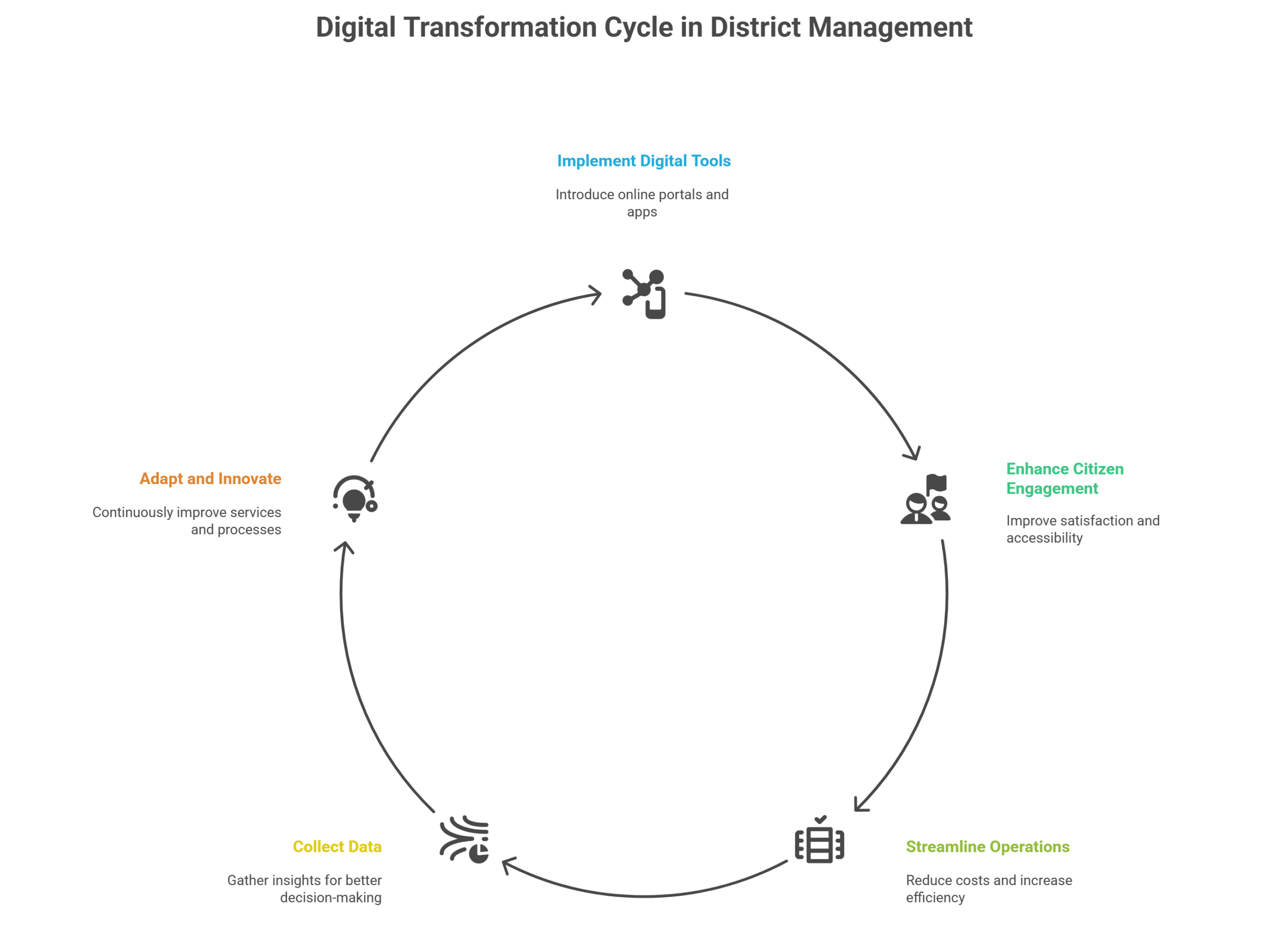

Housing and community development special districts play a vital local role, essentially acting as mini city halls for neighborhoods. Whether managing a new housing development, overseeing affordable housing programs, or maintaining a master-planned community, these districts provide essential services, handle maintenance, and foster community pride. In short, they are the unsung heroes of local district management. However, most operate with very limited staff and outdated communication tools, despite rising public expectations. A recent industry article highlights that increasing demand is “prompting special districts to replace aging technologies and digitize manual processes.” This is where mobile app development for government comes into play. By embracing digital transformation through mobile app solutions, special districts can streamline operations, improve communication, and provide a more efficient, user-friendly experience for residents and staff alike.
Running a housing or community district today is far from easy. Managers juggle many hats from scheduling trash pickup to enforcing community rules, answering resident questions, and managing permits. In practice, this often leads to reactive, paper-based workflows and stressed staff. As one analysis puts it, special districts often suffer from too many calls and too little time: phones ring daily with the same repeated questions, with staff shuffling papers and redirecting inquiries that could have been accessible online, draining resources. The result? Residents wait in limbo for answers to simple questions (like When is the next HOA meeting?), while overworked administrators scramble to sort through emails, voicemails, or community bulletin boards.
Common pain points in traditional district management include:

These challenges are real. In practice, districts see an overflow of routine calls a reactive pattern that is time consuming and a drain on resources, according to one government-services blog. In short, traditional district management often means slow responses, frustrated citizens, and burned-out staff. But there is a better way on the horizon.
Imagine flipping the script: instead of residents hunting for information on fliers or social media, the district delivers it directly to their smartphones. That’s the promise of mobile solutions for districts. By launching a branded district app or mobile portal, a small district team can instantly reach everyone with news, alerts, and services all from one easy interface.
For example, a district-branded mobile app can:
All communication flows through a single trusted platform. In other words, the app becomes a one-stop hub for district info, rather than dozens of scattered channels. As one resource notes, consolidating messages in a mobile app gives citizens an “easy, trusted source” for updates. And because people “increasingly…want the same level of responsiveness and ease when interacting with [their] public entities” as they get from consumer apps, a mobile-first approach meets the expectation of modern residents.
Mobile solutions also transform routine services. For instance, a mobile 311 or service-request feature lets residents report issues like potholes, broken streetlights, or code violations right from their phone. They snap a photo, tap a category, and the report goes straight to the right department or contractor with automatic routing and status updates. This cuts down on those endless phone calls and paperwork. One case study highlights that districts can route requests directly to the correct department and close the loop with citizens faster. The result is fewer lost requests, fewer repeated calls, and happier residents who can track their issue from submission to resolution.
Behind the scenes, staff benefit too. District managers get a user-friendly dashboard where they can assign tasks and track progress in real time. No complex training is required the platform is built for busy local teams. Staff can add notes and photos on the fly for example, snapping a photo of a code violation on their tablet, and residents instantly see updated status. In practical terms, even a two-person office can stay organized: automated workflows reduce admin drudgery, and analytics show open cases and response times at a glance. Everyone knows what’s been done and what still needs attention, without manual spreadsheets.
In short, the right mobile app puts power in everyone’s hands. Residents get fast service and information at their fingertips, while district staff save time and improve accountability. As one source puts it, giving people tools to self serve strengthens trust and engagement. And because the app works on any smartphone or tablet, mobile adoption is maximized remember, studies show a large portion of residents will visit your site from a phone or tablet, and platforms must be mobile-friendly or risk losing engagement. By going mobile, districts meet citizens where they live: on their phones.
Mobile apps are only one piece of the puzzle. Digital transformation in district management means modernizing all key processes moving data, workflows, and services onto secure cloud platforms and easy to use software. It means replacing paper and legacy systems with online forms, digital maps, and integrated databases.
Why does this matter? In today’s world, citizens expect digital convenience everywhere. Government technology solutions experts note that evolving needs and rising expectations are pushing districts to replace aging technologies and digitize manual processes.In practice, this means things like online permitting, cloud-based budgeting, and geospatial asset management. By putting these tools in place, districts work faster and smarter.

For example, the Detroit Water and Sewerage Department serving 700,000 people rolled out a new online portal. Today, 80% of all service transactions are completed online, via the district’s mobile-friendly site. Residents no longer need to visit an office in person for common tasks; they snap photos of their documents with a smartphone and submit everything securely online. The payoff has been huge: customer satisfaction soared to 80% (above the 72% industry average), and first-contact issue resolution jumped from 30% to 75%. Face-to-face service that once took 25 minutes was cut to under 10 minutes online. As the customer service chief put it, it really changed the way we do business, allowing the department to transform and continue adding new services.
Housing and community districts can achieve similar gains. Going digital means residents use online portals or apps to renew permits, pay fees, and sign up for programs – reducing on-site visits and paper forms. Code enforcement officers can fill violation reports on tablets in the field, immediately uploading them to a shared system. Meeting agendas, budgets, and community plans become searchable PDFs on a website instead of dusty binders. All this saves time, cuts costs, and creates an audit trail of information that’s always accessible. In short, digital transformation lets districts do more with less – and meets the growing resident demand for instant, online public services.
The combination of mobile solutions and digital transformation delivers clear results. Government agencies that adopt these tools consistently report measurable improvements, including:
For example, if multiple residents report the same broken water valve via the app, the district can detect the pattern, prioritize repairs, and send an all clear notification instead of treating each report as an isolated incident. This level of insight simply wasn’t possible with old paper systems.
Importantly, these benefits extend throughout the community. When communication is centralized and service delivery is smooth, community engagement grows. Residents see that their district is responsive and transparent, which builds trust. A well designed app can even foster pride: alerting people to upcoming neighborhood clean ups, local festivals, or volunteer opportunities makes them feel connected to the place they live. As one blog puts it, giving special districts the right tools helps build community pride, one notification at a time. In practice, this can mean higher turnout at meetings, more volunteers for events, and a stronger sense of belonging in the neighborhood.
Building a stronger housing or community district is within reach. By upgrading district management through mobile solutions and digital transformation, you can transform how your community communicates, solves problems, and thrives. Ready to make your district more efficient, transparent, and connected? Get in touch now to learn how our mobile app and digital services can empower your team and elevate resident satisfaction. Together, we’ll modernize your district management and help your community flourish.
The organized oversight of local services like utilities, permits, and communications delivered through mobile/cloud tools for clearer, faster operations.
A district branded app sends targeted push alerts, event updates, and service request tools directly to smartphones making interaction timely and intuitive.
It’s shifting services like payments, permitting, and reporting from paper and phone to secure digital/mobile platforms, boosting transparency and efficiency.
They allow residents to submit issue reports with photos and precise location details, automatically routing to the right team and enabling real-time resolution tracking.
Absolutely modern apps meet WCAG 2.1 standards, ensuring accessibility for users with disabilities, elderly residents, and multilingual communities.
Look for drops in phone/email inquiries, faster service fulfillment, improved resident satisfaction, and analytics driven insights from app dashboards.
They allow residents to submit issue reports with photos and precise location details, automatically routing to the right team and enabling real-time resolution tracking.
Commodo elementum, sed imperdiet nunc euismod etiam aliquet viverra

App Maisters Inc is a Federal Government SBA 8(a) Certified and Texas Hub Certified company. We are a leading developer of high-performance mobile apps, websites, and enterprise solutions, that are specially designed to meet Federal, State, Local government agencies and higher education needs.
